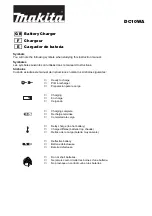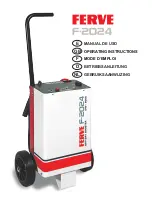
TROUBLESHOOTING / FAULT CODES
FAULT
CODES
CAUSE
SOLUTION
SPECIFICATIONS
1. UNIT WEIGHT ..1.2 lb.
2. INPUT..................120 Volt AC, 60 Hz, 0.76A
3. OUTPUT .............6 Volt DC, 3 AMP/12 Volt DC, 3 AMP
4. UNIT DIMENSIONS(housing)....1.96 in. (H) x 3.58 in. (W) x 6.50 in. (D)
5. IN-LINE FUSE .................................7.5 AMP-SPADE TYPE (on positive
cable with cover)
© 2017 JEGS.
Made in China.
CUSTOMER SERVICE available 24 hours,
7 days a week. For Questions or comments contact
us at: www.jegs.com or call 1-800-345-4545.
In the unlikely event of a problem with this unit,
do not return it to the place of purchase. Please
contact costumer service at: 1-800-345-4545.
TWO YEAR LIMITED WARRANTY
JEGS is dedicated to making high quality products for every consumer. We are so confident in the quality of our merchandise that we offer a two year limited
warranty with this product. If JEGS concludes that the product is defective during this period, we will repair it or replace it free of charge. Warranty is available
only if original purchase is made in the USA during period covered by warranty. For Customer Service in the USA, visit www.jegs.com or call toll-free at
1-800-345-4545. Please mail all defective products to 101 JEGS Place, Delaware, Ohio 43015. Add a letter with contact information: email address (if you have
one), name, address, telephone number, and problem with product. Do not send any products to JEGS without first contacting Customer Service.
REPAIR OR REPLACEMENT OF THE DEFECTIVE PRODUCT OR COMPONENT PROVIDED UNDER THIS WARRANTY SHALL NOT APPLY IF THE PRODUCT: (a) IS
USED FOR COMMERCIAL PURPOSES AND/OR FROM IMPROPER USE IN AN UNSUITABLE ENVIRONMENT (b) IS MODIFIED OR TAMPERED WITH EITHER
INTERNALLY OR EXTERNALLY; (c) IS DAMAGED RESULTING FROM MISUSE, NEGLIGENCE, LACK OF REASONABLE MAINTENANCE AND CARE, OR BY OTHER
CAUSES UNRELATED TO DEFECTIVE MATERIAL OR WORKMANSHIP; (d) IF THE PRODUCT HAS BEEN SUBJECTED TO FIRE, WATER, OR GENERAL CORROSION.
This warranty gives you specific legal rights, and you may also have other rights which vary from State to State in the U.S.A. or province to province in Canada.
WARNING: This product may contain chemicals known to the state of California to cause cancer, birth defects, or other reproductive harm. Wash hands after handling!
APPROXIMATE CHARGING TIMES
The built-in intelligent microprocessor will continuously monitor and adjust the maintainer to provide a fast, safe and
efficient charge. Note that battery charge times will vary depending on several factors including:
Battery State – If a battery has been only slightly discharged, it can be charged in less than a few hours. This same battery
could take up to 10 hours if very discharged.
Battery Rating – A higher rated battery will take longer to charge than a lower rated battery under the same conditions. A
battery is rated in ampere-hours (Ah), reserve capacity (RC) and cold-cranking amps (CCA).
Charge Rate –The charge rate is measured in amps. A battery charged at a lower rate will take longer than a battery charged
at a higher rate. However, smaller batteries can be easily damaged by charging at a rate which is too high for the capacity of
the battery.
Temperature – Cold temperature will affect a batteries ability to accept a charge. Charging in cold temperatures will increase
the amount of time required to charge a battery.
Find your battery’s CCA rating in the table below and note the charging time. The time reflects a battery with at least 50%
charge. You may need to add time depending on the severity of discharge.
CARE AND MAINTENANCE
With proper care and minimal maintenance, the JEGS 3A Battery Maintainer No. 81954 will provide years of dependable service.
For maximum performance, manufacturer recommends: After each use, clean the battery maintainer clips - be sure to remove any
battery fluid that will cause corrosion on the clips. Always unplug and disconnect unit before cleaning. Clean the outside case of the
maintainer with a soft cloth and, if necessary, mild soap solution. Do not allow liquid to enter the maintainer . Do not operate when
maintainer is wet. Keep the maintainer cords loosely coiled during storage to prevent damage to the cords. Store in cold, dry loaction.
BATTERY RATING / SIZE
CHARGING TIME
Small Batteries
(ATV, Lawn Tractor, Motorcycle, etc.)
Marine Deep Cycle
6 – 12 Ah
12 – 32 Ah
2 ½ – 4 hours
5 – 13½ hours
Cars/Trucks
200-315 CCA
315-500 CCA
550-1000 CCA
40 – 60 RC
60 – 85 RC
80 – 190 RC
Maintain only
80 RC /140 RC / 160 RC / 180 RC
Maintain only
Ah=Amp Hour
CCA=Cold Cranking Amps
RC=Reserve Capacity
F01
Dead battery.
Consult a technician
F02
F03
F04
The maintainer is overheating.
F05
F06
Reverse polarity occurs.
Reconnect the battery clips correctly.
An appliance is drawing power from the battery being charged. Disconnect appliance and try to charge again
Use a charger/maintainer with a higher current.
Verify battery and select correct charging voltage. (6 or 12 Volt)
Make sure vents are clear. Unit will resume charging when cooled.
Disconnect the unit with battery and recharge again. Do not use the battery
for other purposes when it is charging. Check the battery conditions.
Charging rate is too small relative to size of the battery.
Maintainer voltage is too high relative to battery.
Consult a technician to check unit.
Maintainer error, charge current is higher than selected.
Does not enter the float stage after 24 hours or the battery
is defective.
FCC NOTE: Please note that changes or modifications not expressly approved by the
party responsible for compliance could void the user’s authority to operate the
equipment.
NOTE: This equipment has been tested and found to comply with the limits for a Class B
digital device, pursuant to Part 15 of the FCC Rules. These limits are designed to provide
reasonable protection against harmful interference in a residential installation. This
equipment generates, uses and can radiate radio frequency energy and, if not installed
and used in accordance with the instructions, may cause harmful interference to radio
communications. However, there is no guarantee that interference will not occur in a
particular installation. If this equipment does cause harmful interference to radio or
television reception, which can be determined by turning the equipment off and on, the
user is encouraged to try to correct the interference by one or more of the following
measures: Reorient or relocate the receiving antenna. Increase the separation between
the equipment and receiver. Connect the equipment into an outlet on a circuit different
from that to which the receiver is connected. Consult the dealer or an experienced
radio/TV technician for help.


























